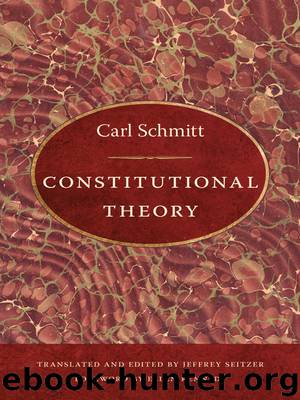Constitutional Theory by Carl Schmitt

Author:Carl Schmitt
Language: eng
Format: epub
Tags: ebook, book
Publisher: Duke
Published: 2011-09-25T16:00:00+00:00
2. No Influence of L on E
(Parliament opposed to government and administration)
(a) General prohibition of the preemption of executive acts by L.
One such preemption is found in Art. 46 Title V of the Constitution of the Directory of the Year III (1795). Today, such a general prohibition is no longer expressed because of the budget law of parliament and its authority for parliamentary supervision.
(b) No selection of the chief of state or of the government by L.
Art. 2 of the French Constitutional Law of 24 February 1875 is quite different in that it provides that the president of the Republic is selected by a “national assembly,” which is a legislative body arising in such a way that both chambers (Senate and House of Deputies) convene as one body. Also different is Art. 45 of the Prussian constitution of 1920. There the Land parliament selects the minister president without deliberation, and the minister president appoints the other state ministers (the chief of state, however, appoints the state ministry).
The Weimar Constitution, by contrast, strictly implements the principle of the separation (according to the model of the federal Constitution of the United States). Art. 41, 1, stipulates that “the Reich President is elected by the entire German people,” while, according to Art. 53, “the Reich Chancellor is appointed and dismissed at his suggestion; the Reich ministers are appointed and dismissed by the President.” In this regard, however, cf. section d. below.
(c) No complaint authority and no court claims of L against E.
By contrast, see the system of ministerial and presidential complaint by the Chamber of Deputies, with the power of judgment of the other chamber (upper house) serving as a state high court. Hence Art. 9 of the French Constitutional Law of 24 February 1875, discussed above § 12, 5b, p. 135. [192]
The Weimar Constitution honors the perspective of separation insofar as a special Staatsgerichtshof for the German Reich decides on the complaint raised by the Reichstag, Art. 59. (above p. 135).
(d) No dependence of the government on the confidence of the parliament (no vote of no confidence).
Hence, the federal Constitution of the United States of America of 1787, the French constitution of 1791, and the constitutions of the German constitutional monarchy.
Art. 54 of the Weimar Constitution differs: “The Reich Chancellor and the Reich ministers require the confidence of the Reichstag for the execution of their office. Each of them must resign if the Reichstag withdraws its confidence through explicit decision.”
(e) No petition of L for the removal of the chief of state by popular vote.
Contrast Art. 43 of the Weimar Constitution. “Before the expiration of the term (the period of office of seven years),” it reads, “the President can be removed by popular vote at the instigation of the Reichstag. The Reichstag vote requires a two-thirds majority. By this decision, the President is prevented from further exercise of the office. The rejection of the removal by the popular vote counts as a new election and results in the dissolution of the Reichstag.”
(f) No consent of L to the criminal prosecution of the chief of state.
Download
This site does not store any files on its server. We only index and link to content provided by other sites. Please contact the content providers to delete copyright contents if any and email us, we'll remove relevant links or contents immediately.
| Anthropology | Archaeology |
| Philosophy | Politics & Government |
| Social Sciences | Sociology |
| Women's Studies |
The Secret History by Donna Tartt(16608)
The Social Justice Warrior Handbook by Lisa De Pasquale(11485)
Thirteen Reasons Why by Jay Asher(7782)
This Is How You Lose Her by Junot Diaz(5753)
Weapons of Math Destruction by Cathy O'Neil(5029)
Zero to One by Peter Thiel(4817)
The Myth of the Strong Leader by Archie Brown(4785)
Promise Me, Dad by Joe Biden(4440)
Stone's Rules by Roger Stone(4412)
Beartown by Fredrik Backman(4404)
How Democracies Die by Steven Levitsky & Daniel Ziblatt(4392)
The Fire Next Time by James Baldwin(4336)
100 Deadly Skills by Clint Emerson(4070)
A Higher Loyalty: Truth, Lies, and Leadership by James Comey(4024)
Rise and Kill First by Ronen Bergman(4008)
The David Icke Guide to the Global Conspiracy (and how to end it) by David Icke(3875)
The Farm by Tom Rob Smith(3869)
Secrecy World by Jake Bernstein(3773)
The Doomsday Machine by Daniel Ellsberg(3725)
